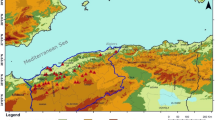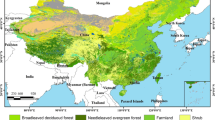Abstract
The current research explores the relationship between meteorological drought and land-cover changes locally via the normalized difference vegetation index (NDVI) and standard precipitation index (SPI). The historical time-series dataset of rainfall from 1981 to 2018 was used to compute the SPI, whereas the NDVI and land use/land cover (LULC) for the year 2016–2018 were calculated from the Sentinel-2 dataset of the studied region. The positive (r = 0.82, r = 0.79, and p = 0.001) and negative (r = 0.51 and p = 0.087) correlations were observed between NDVI and SPI data during 2016–2018. The 1 month scale of the SPI was positively correlated with NDVI. It was noticed that the maximum and minimum correlations occurred during the starting and end of the growing period, respectively. The multiple regression models were developed based on the correlation coefficients to predict the NDVI and investigate the relationship between the NDVI and SPI. The models have predicted accuracy (R2) of 0.68, 0.63, and 0.26 for the normal (2016), moderate (2017), and severe drought (2018) years, respectively. The drastic changes in an LULC were noticed during the regular and severe drought years.











Similar content being viewed by others
References
Rousta I, Olafsson H, Moniruzzaman M, Ardö J, Zhang H, Mushore TD, Shahin S, Azim S. The 2000–2017 drought risk assessment of the western and southwestern basins in Iran. Model Earth Syst Environ. 2020;6(2):1201–21.
Sobhani B, Zengir VS. Modeling, monitoring and forecasting of drought in south and southwestern Iran, Iran. Model Earth Syst Environ. 2020;6(1):63–71.
Gaikwad SV, Vibhute AD, Kale KV, Dhumal RK, Nagne AD, Mehrotra SC, Surase RR. Drought severity identification and classification of the land pattern using Landsat 8 data based on spectral indices and maximum likelihood algorithm. In: Microelectronics, electromagnetics and telecommunications. Springer; 2019. p. 517–24.
McKee TB (1995) Drought monitoring with multiple time scales. In Proceedings of 9th Conference on Applied Climatology, Boston, 1995.
Gaikwad SV, Vibhute AD, Kale KV, Nalawade DB, Jadhav MB (2018) Design and Development of ground truth collection platform using android and leaflet library. In International Conference on Recent Trends in Image Processing and Pattern Recognition. Springer, Singapore. pp. 520–528.
Dutta D, Kundu A, Patel NR. Predicting agricultural drought in eastern Rajasthan of India using NDVI and standardized precipitation index. Geocarto Int. 2013;28(3):192–209.
Sierra-Soler A, Adamowski J, Malard J, Qi Z, Saadat H, Pingale S. Assessing agricultural drought at a regional scale using LULC classification, SPI, and vegetation indices: case study in a rainfed agro-ecosystem in Central Mexico. Geomat Nat Haz Risk. 2016;7(4):1460–88.
Ozelkan E, Chen G, Ustundag BB. Multiscale object-based drought monitoring and comparison in rainfed and irrigated agriculture from Landsat 8 OLI imagery. Int J Appl Earth Obs Geoinf. 2016;44:159–70.
Ackom EK, Adjei KA, Nii OS. Monitoring land-use and land-cover changes due to extensive urbanization in the Odaw River Basin of Accra, Ghana, 1991–2030. Model Earth Syst Environ. 2020;6(2):1131–43.
Patil NS, Nataraja M. Effect of land use land cover changes on runoff using hydrological model: a case study in Hiranyakeshi watershed. Model Earth Syst Environ. 2020;6(4):2345–57.
Shahi E, Karimi S, Jafari HR. Monitoring and modeling land use/cover changes in Arasbaran protected Area using and integrated Markov chain and artificial neural network. Model Earth Syst Environ. 2020;6:1901–11.
Quaye-Ballard JA, Okrah TM, Andam-Akorful SA, Awotwi A, Osei-Wusu W, Antwi T, Tang X. Assessment of vegetation dynamics in Upper East Region of Ghana based on wavelet multi-resolution analysis. Model Earth Syst Environ. 2020;6(3):1783–93.
Dutta D, Kundu A, Patel NR, Saha SK, Siddiqui AR. Assessment of agricultural drought in Rajasthan (India) using remote sensing derived Vegetation Condition Index (VCI) and Standardized Precipitation Index (SPI). Egypt J Remote Sens Space Sci. 2015;18(1):53–63.
Vibhute AD, Kale KV, Mehrotra SC, Dhumal RK, Nagne AD. Determination of soil physicochemical attributes in farming sites through visible, near-infrared diffuse reflectance spectroscopy and PLSR modeling. Ecol Process. 2018;7(1):1–12.
Gaikwad SV, Vibhute AD, Kale KV, Mane AV (2021) Vegetation cover classification using Sentinal-2 time-series images and K-Means clustering. In 2021 IEEE Bombay Section Signature Conference (IBSSC). pp. 1–6. IEEE.
Kong F, Huang B, Bradbury K, Malof J (2020) The Synthinel-1 dataset: a collection of high resolution synthetic overhead imagery for building segmentation. In Proceedings of the IEEE/CVF Winter Conference on Applications of Computer Vision. pp. 1814–1823.
Thom HC. A note on the gamma distribution. Mon Weather Rev. 1958;86(4):117–22.
Zhou H, Liu Y. SPI based meteorological drought assessment over a humid basin: effects of processing schemes. Water. 2016;8(9):373.
Geerken R, Zaitchik B, Evans JP. Classifying rangeland vegetation type and coverage from NDVI time series using Fourier Filtered Cycle Similarity. Int J Remote Sens. 2005;26(24):5535–54.
Vibhute AD, Kale KV, Gaikwad SV, Dhumal RK, Nagne AD, Varpe AB, Mehrotra SC. Classification of complex environments using pixel level fusion of satellite data. Multimed Tools Appl. 2020;79:34737–69.
Li S, Xu L, Jing Y, Yin H, Li X, Guan X. High-quality vegetation index product generation: a review of NDVI time series reconstruction techniques. Int J Appl Earth Obs Geoinf. 2021;105: 102640.
Gaikwad SV, Vibhute AD, Kale KV. Estimation of area sown and sowing dates of in-season rabi crops using sentinel-2 time series data. J Res ANGRAU. 2021;49(1):69–81.
Breiman L. Random forests. Mach Learn. 2001;45(1):5–32.
Liu Y, Wang Y, Zhang J (2012) New machine learning algorithm: random forest. In International Conference on Information Computing and Applications. Springer, Heidelberg. pp. 246–252.
Khan A, Vibhute AD, Mali S, Patil CH. A systematic review on hyperspectral imaging technology with a machine and deep learning methodology for agricultural applications. Ecol Inform. 2022;69:101678.
Kong F, Chen C, Huang B, Collins LM, Bradbury K, Malof JM (2019) Training a single multi-class convolutional segmentation network using multiple datasets with heterogeneous labels: preliminary results. In IGARSS 2019–2019 IEEE International Geoscience and Remote Sensing Symposium. pp. 3903–3906. IEEE.
Kong F, Henao R (2022) Efficient classification of very large images with tiny objects. In Proceedings of the IEEE/CVF Conference on Computer Vision and Pattern Recognition pp. 2384–2394.
Acknowledgements
The authors would like to thank the Indian Meteorological Department (IMD), the Government of India, for providing the precipitation data. The authors would like to also thank ESA for providing the satellite data.
Author information
Authors and Affiliations
Contributions
SVG: conceptualization, data curation, methodology, and writing—original draft. ADV: investigation, methodology, modeling, experiments, validation, and writing—review & final editing. KVK: supervision, technical advice, and scientific validation. All authors read and approved the final manuscript.
Corresponding author
Ethics declarations
Conflict of Interest
All the authors declare that he/she has no conflict of interest.
Ethical Approval
This article does not contain any studies with animals performed by any of the authors.
Additional information
Publisher's Note
Springer Nature remains neutral with regard to jurisdictional claims in published maps and institutional affiliations.
This article is part of the topical collection “Soft Computing and its Engineering Applications” guest edited by Kanubhai K. Patel, Deepak Garg, Atul Patel and Pawan Lingras.
Rights and permissions
Springer Nature or its licensor holds exclusive rights to this article under a publishing agreement with the author(s) or other rightsholder(s); author self-archiving of the accepted manuscript version of this article is solely governed by the terms of such publishing agreement and applicable law.
About this article
Cite this article
Gaikwad, S.V., Vibhute, A.D. & Kale, K.V. Assessing Meteorological Drought and Detecting LULC Dynamics at a Regional Scale Using SPI, NDVI, and Random Forest Methods. SN COMPUT. SCI. 3, 458 (2022). https://doi.org/10.1007/s42979-022-01361-0
Received:
Accepted:
Published:
DOI: https://doi.org/10.1007/s42979-022-01361-0




